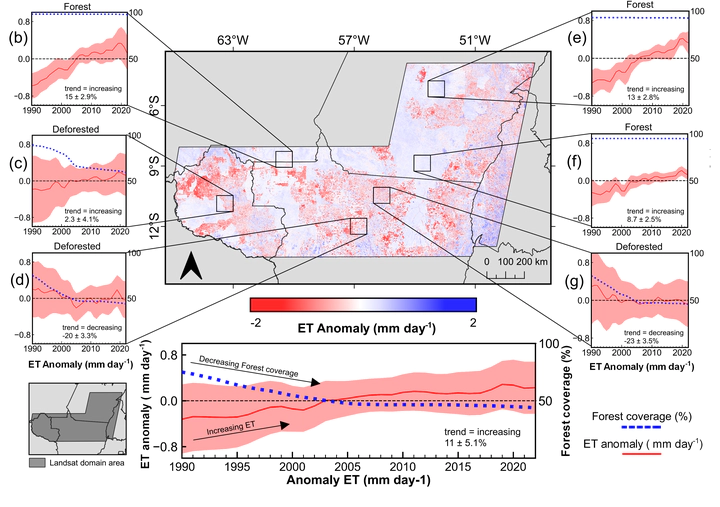 Dry-season evapotranspiration (ET) anomaly along the Amazon arc of deforestation for the last year of the time series (2022). ET anomalies between 1990 and 2022 present opposite results for forested (positive) and deforested (negative) areas. The total 𝐸𝑇 increases by 11 ± 1.5% (a) due to the larger proportion of forested areas in the study region. We identified trends for specific regions (20,000km²) over the domain area: (b) Forest, located between the states of Mato Grosso and Pará and part of an indigenous land; (c) Deforested area, located in the state of Rondônia, replaced with pasture; (d) Deforested area, with intense irrigated croplands expansion; (e) Forest, located in an indigenous land; (f) Forest, located in an indigenous land; (g) Deforested area, replaced with croplands. Shaded areas in the anomalies time series plots represent the standard deviation.
Dry-season evapotranspiration (ET) anomaly along the Amazon arc of deforestation for the last year of the time series (2022). ET anomalies between 1990 and 2022 present opposite results for forested (positive) and deforested (negative) areas. The total 𝐸𝑇 increases by 11 ± 1.5% (a) due to the larger proportion of forested areas in the study region. We identified trends for specific regions (20,000km²) over the domain area: (b) Forest, located between the states of Mato Grosso and Pará and part of an indigenous land; (c) Deforested area, located in the state of Rondônia, replaced with pasture; (d) Deforested area, with intense irrigated croplands expansion; (e) Forest, located in an indigenous land; (f) Forest, located in an indigenous land; (g) Deforested area, replaced with croplands. Shaded areas in the anomalies time series plots represent the standard deviation.Abstract
The Brazilian Amazon Forest is experiencing alterations in water fluxes driven by agriculture expansion and climate change, which affect land-atmosphere interactions and precipitation recycling. Evapotranspiration (ET) is central to understand these processes, as it regulates water transport across the Amazon. However, its long-term responses to ongoing climate change and human activities remain poorly understood. This study conducted a multi-scale analysis of ET trends from basin to local scale in the most deforested region of the Brazilian Amazon. We applied a remote sensing-based model (geeSEBAL) from 1990 to 2022 to assess deforestation and climate change effects on ET. Our results indicate that overallET in the Amazon arc of deforestation has increased by 11% during the dry season despite significant forest removal, largely due to the contribution of intact forests and global warming feedback. While these findings suggest a forest response to a changing climate, they also highlight a critical vulnerability that is exacerbated by the threat of ongoing deforestation. With projected warmer future climate and extended dry seasons, our results emphasize the complex interplay between water recycling and climate change in the world’s largest rainforest, with significant ecological and water security implications.